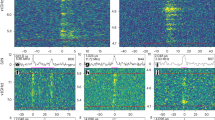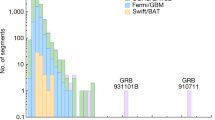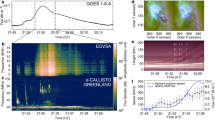Abstract
During both Voyager encounters with the saturnian system, the Planetary Radio Astronomy (PRA) experiment detected strong discrete episodic bursts of radio emission, termed Saturn electrostatic discharges (SED)1–3. An examination of Voyager 2 photopolarimeter (PPS) data now reveals a narrow feature (possibly a gap) in Saturn's B ring. A single, unique object appears to be responsible for both the SED and this feature.
This is a preview of subscription content, access via your institution
Access options
Subscribe to this journal
Receive 51 print issues and online access
$199.00 per year
only $3.90 per issue
Buy this article
- Purchase on Springer Link
- Instant access to full article PDF
Prices may be subject to local taxes which are calculated during checkout
Similar content being viewed by others
References
Warwick, J. W. et al. Science 212, 239–243 (1981).
Evans, D. R., Warwick, J. W., Pearce, J. B., Carr, T. D. & Schauble, J. J. Nature 292, 716–718 (1981).
Warwick, J. W. et al. NASA tech. Mem. 83856 (1981).
Northrop, T. G. & Hill, J. R. J. geophys. Res. (submitted).
Author information
Authors and Affiliations
Rights and permissions
About this article
Cite this article
Evans, D., Romig, J., Hord, C. et al. The source of Saturn electrostatic discharges. Nature 299, 236–237 (1982). https://doi.org/10.1038/299236a0
Received:
Accepted:
Issue Date:
DOI: https://doi.org/10.1038/299236a0
This article is cited by
-
Atmospheric Electricity at Saturn
Space Science Reviews (2008)
-
Atmospheric storm explanation of saturnian electrostatic discharges
Nature (1983)
Comments
By submitting a comment you agree to abide by our Terms and Community Guidelines. If you find something abusive or that does not comply with our terms or guidelines please flag it as inappropriate.



